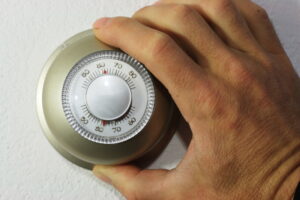
There’s probably some point where you’ve sat behind the wheel of a car, looked at the speedometer, and wondered, “How fast could I really drive this thing if I wanted?” Would it go as fast as the upper limit on the speedometer? Would it fall short, or maybe go faster?
We don’t encourage you to try this, of course, but we understand the desire. We can apply this to the air conditioning system in your house. You look at the thermostat settings and see the lowest temperature (usually 60°F). Can the AC make your house that cool? Even cooler? Is there a limit on what your AC can do when removing heat from the house to lower the temperature?
Yes, there is a limit. We’ll explain more below.
The Temperature Differential for an AC
The limit an air conditioner has is called the temperature differential. This is how much the AC system can lower the indoor temperature compared to the outdoor temperature. For most residential central air conditioners, the temperature differential is 20°F—i.e. your AC can make the house 20°F cooler than the outside.
On most days, this 20° differential is enough for air conditioning in Dunedin FL, to maintain pleasant indoor conditions with balanced humidity around 55%. On an 85°F day, you could potentially lower the AC down to 65°F, although that’s too cold for most people. Setting the thermostat to 75°F is only a 10° difference, and the air conditioner can handle that without problem and not have to run continuously throughout the day.
But if the outdoor temperature is 100°F, setting the thermostat lower than 80°F is asking the air conditioning to work beyond its limits. It simply can’t pump out enough heat to cool the house any more than that. What will happen is the AC will run constantly as it tries to reach a temperature that’s out of its range. This continual running can also lead to excess humidity in the house—not something you want to happen in Florida.
Managing Settings for the Heat
On most summer days, you won’t run into a problem finding a comfortable setting on the thermostat that doesn’t put massive strain on the AC. The recommended energy-saving temperature during the daytime when people are home is 78°F, which can manage outdoor temperatures up to 98°F. This higher setting is helpful at slowing down heat gain in the house: the nearer the indoor and outdoor temperatures are to each other, the slower the house heats up and the less the AC needs to work.
If you find that 78°F feels too warm for some of your household, set the thermostat lower and raise it by one degree a day until you reach 78°F. This will help people adjust to the temperature. During the evening, raise the thermostat by 8°–10°, and also do this when you’re away from home. This will prevent the house from getting too hot during your absence so you won’t have to keep the AC running on full for hours to cool it down again.
Schedule your air conditioning services with The A/C Guy of Tampa Bay Inc. Serving our Tampa Bay family with integrity and honor.

